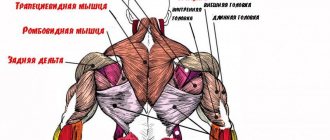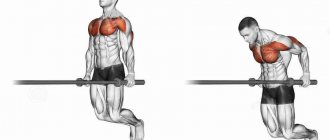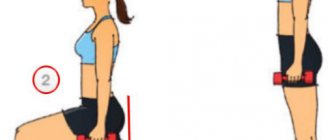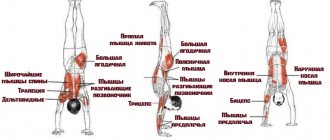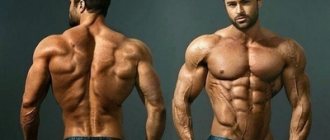Why do you need to pump your arms?
Yes, in fact, it is not necessary and not particularly necessary to pump them up :), because they make up 5-7% of all muscle volumes of the body, so theoretically they cannot give any significant increase in weight.
Often, many training programs, for example, for ectomorphs, completely exclude this muscle group or devote the least time to it. Of course, the hands are involved in almost all movements and receive their load indirectly, but still it cannot be compared with targeted and highly specialized work. Therefore, you need to shake your hands, at least for this reason:
- As various surveys show, ladies pay significant attention to their hands. In muscular arms they feel the strength and ability to protect and not allow them to be offended;
- pumped up arms look good in summer in various sleeveless T-shirts - this is a sign of good physical shape of their owner;
- when you are asked to show your pumped up muscles, you always show your biceps;
- in the men's world, volume matters, so if you have weak hands, then the attitude towards you is appropriate;
- strong hands are the ability to resist holds/choke and deliver a crushing blow to an opponent;
- for women, toned arms and strong forearms/hands are a plus in everyday life, such as carrying bags or carrying a child;
- for women - this is the absence of jelly and various sagging under the arms;
- If you have muscle-toned arms, you can afford sleeveless and open-shoulder dresses.
Anatomical atlas of arm muscles
The arm muscles have many large, externally visible muscles that help us in everyday activities, such as changing clothes or using a PC.
The muscles of the upper limbs are divided into:
- shoulder muscles, which in turn are divided into the anterior group (flexors) - brachialis, coracobrachialis, biceps and posterior (extensors) - ulna, triceps;
- The muscles of the forearm are the largest, these are the brachialis (brachialis) and brachioradialis (brachiradialis).
From the point of view of occurrence, it is customary to distinguish:
- superficial (clearly visible on the surface) – biceps, triceps, brachyradialis, long extensor carpi radialis, deltoids;
- deep muscles - lie deep on the surface.
The muscles of the upper arm are responsible for flexion/extension of the forearm at the elbow joint. Flexion of the forearm is achieved by a group of three muscles - the brachialis, biceps and brachyradialis.
In general, in the literature on anatomy it is not customary to translate the names of muscle groups, i.e. there, for the preservation of the original Latin names, for example, brachialis will be musculus brachialis. In this regard, a more correct “Latin anatomical picture” of the arm muscles will look like this.
Let's look at the major large muscle units individually.
No. 1. Biceps
The large, thick fusiform brachii muscle is located on the upper part of the humerus, consisting of 2 heads - long and short. Both originate in the shoulder area, attach below to the round eminence of the forearm bone, and unite in the middle of the shoulder.
The biceps performs the following functions:
- works as a forearm supinator by turning and moving the palm upward;
- flexes forearm/shoulder;
- flexes the upper arm (raising the arm forward and up).
No. 2. Triceps
The triceps fusiform muscle lies on the back of the shoulder. It has three heads - lateral, medial and long, which merge on the olecranon of the ulna. The lateral and medial heads of the triceps originate on the humerus, the long head begins on the scapula.
The triceps performs the following functions:
- extends the elbow joint/helps straighten the arm - acts as an extensor of the forearm at the elbow joint and humerus at the shoulder;
- The long head also assists the latissimus dorsi during the bench pullover exercise, bringing the arm down toward the body.
Summarizing the “head” muscles, the combined anatomical picture of biceps + triceps looks like this.
No. 3. Forearm muscles
The most famous and largest muscles of the wrist are: brachialis, brachyradialis, flexor carpi radialis longus and coracoid muscles. Let's look at them in more detail.
3.1. Brachialis
Most of the muscles that move the wrist, arm and fingers are found in the forearm - they are thin, like a strap. The brachialis is a flat, fusiform muscle that lies under the biceps on the lower anterior surface of the shoulder. The beginning is attached to the bottom of the humerus, and the “end” is attached to the bony eminence of the forearm.
Brachialis performs the following functions:
- the main and strongest ulnar flexor - responsible for bending the elbow in any position of the hand (supination, pronation, neutral).
3.2. Brachyradialis
This is a fusiform muscle located on the front surface of the forearm. Originates at the lower outer part of the shoulder, crosses the elbow and extends to the radius (outer lower part). To see the muscle, tense your forearm and move your thumb to the side; the brachiralis will “appear” near the elbow, closer to the biceps tendon.
The brachioradialis muscle performs the following functions:
- bends the elbow;
- plays an active role in the up/down rotation of the forearm.
3.3. Extensor carpi radialis longus
On the back of the arm are extensor muscles such as extensor carpi ulnaris and extensor digitorum longus, which act as antagonistic flexors. The extensors are somewhat weaker than the flexors.
The extensor carpi radialis longus muscle is located next to the brachyradialis and is one of the 5 major muscles that help move the wrist. When a person clenches a fist, this muscle is actively involved and protrudes from the skin.
3.4. Coracobrachialis muscle
A long, narrow, beak-shaped muscle located on the inner surface of the shoulder. At the top it is attached near the coracoid process of the scapula, and at the bottom - to the front inner part of the arm. This muscle is not an elbow flexor
The coracobrachialis muscle performs the following functions:
- bringing the arm toward the body with the elbow bent.
A composite atlas of all the muscles of the forearms looks like this.
Actually, we're done with anatomy. Friends, are you still here...or am I just shaking the air? :). Let's go further and now talk about practical training aspects.
Supination and pronation - what is it?
These are two special movements produced by the muscles of the forearms - supination (turning outward) and pronation (turning inward). Supination is produced by the biceps and the muscles of the round supinator of the forearms, pronation - by the muscles of the pronator teres of the forearms.
It turns out that different grips on equipment (for example, dumbbells) provide different types of work for the arms and different degrees of participation of the biceps/triceps and forearms muscles.
Exercises without additional equipment (calisthenics)
We will start with the most complex and basic version of pumping the deltoid muscles. Upside down push-ups are perhaps the best exercise for the deltoid muscles in outdoor conditions without additional weights. This version of push-ups is not suitable for everyone, but it has no equal in terms of effectiveness in calisthenics. This exercise will add volume, strength and definition to your shoulders.
Instead of the previous option, you can use house push-ups. It is easier to perform, but also quite effective. Well, if this option turned out to be difficult for you, then try doing push-ups, leaning on the racks of the parallel bars. Here you can adjust the resistance yourself thanks to body position and muscle con src=»https://street-sport.com/wp-content/uploads/2019/10/10-otvedeniya-ruk-na-brusyah.jpg» class=» aligncenter» width=»600″ height=»325″[/img]As for the middle of the deltas, in this case there is an excellent option that will specifically iron this area. Here it is important to feel the working bundle so as not to load additional muscles. If when performing this exercise you feel severe discomfort in the joint, then it is better to refrain from doing it. You can also put something soft under your hand.
In addition to the previous exercise, you can also use this non-standard exercise. It affects two beams at once, and to make it even more difficult, you can use a regular towel.
To load the rear deltoids, you can use pull-ups on a low horizontal bar. For the back bun to work, you need to spread your elbows to the sides, and to make it heavier, you can put your feet on a hill. Well, if this option is not enough for you, then it is best to do pull-ups on a towel, spreading your elbows out to the sides as much as possible; the effectiveness of this option increases significantly.
So we looked at all the exercises for the deltoid muscles in outdoor conditions, if you still have questions, then ask them in the comments.
How to pump up deltoids on the horizontal bar?
In general, pull-ups are not a specialized exercise for developing deltoid muscles. The deltoids act here as “auxiliary” muscles. However, all types of pull-ups allow you to include them in your work.
One of the functions of the anterior delta is shoulder flexion, that is, raising the arm in front of you until it is parallel to the floor. At approximately the midpoint of the lift, when pulling up, the shoulders are parallel to the floor, which means that the deltoids are under tension.
More effective in terms of stress on the anterior deltoid muscles of the shoulders are pull-ups with a straight medium grip and partial pull-ups.
- Pull-up with a medium straight grip Starting position – hanging, bending at the back. Your legs need to be bent at the knees and crossed. As you pull yourself up, you simultaneously bring your shoulder blades together. At the highest point of the lift, we touch the bar of the horizontal bar with the top of our chest. When descending, we straighten our arms almost completely to give a good stretch to the back muscles.
- Partial pull-up with a medium reverse grip. Performed from the same starting position as the first exercise. The pull-up does not occur to the maximum point, but to the middle of the amplitude. At this point you need to fix the body and bend the forearms, trying to bring the collarbones as close as possible to the crossbar. The delta experiences the greatest tension precisely while holding the body in the middle of the lift, when the forearms are parallel to the floor. This exercise also works great on the biceps of the shoulders. To get the load on the rear deltoids, pull yourself up with a narrow reverse grip.
- Pull-up with a narrow reverse grip. The starting position, as usual, is hanging, bending over. Pulling yourself up, we bring your shoulder blades together and move your shoulders back, while trying to touch the horizontal bar with your lower chest, directing your gaze to your hands.
However, powerful shoulders cannot be imagined without well-developed trapezius muscles.
Recommendations on how to pump up the shoulder girdle on the horizontal bar
- Warm up before performing a set of effective exercises. At the end of the lesson, stretch and take a warm shower. All this will protect the shoulder joints.
- Make all movements smoothly. Concentrate on technique.
- If you want to avoid blisters, wear training gloves.
- Slowly lower yourself from the horizontal bar. Otherwise, there is a risk of damaging the spine.
- Approach your training systematically. Perform exercises on the horizontal bar regularly, gradually progressing the load. Pay attention to your sleep schedule.
- As you move, focus on tensing your muscles.
- Pull yourself up as you exhale. Lower while inhaling.
- The descent time must be equal to the ascent time.
Preparation for classes
- To train at home, men need to purchase a wall bars with a horizontal bar or install a crossbar in the doorway.
- Sports gloves will save the athlete from calluses. Also try using talcum powder on your hands.
- Prepare weights so you can progress the load on your shoulders for maximum effect.
- The horizontal bar should be securely fastened. Its downward deflection is unacceptable.
- Use different grip options for training: straight, reverse, intermediate.
- To increase muscle mass, use weights. Place a backpack with additional weight on your shoulders. To dry, do more repetitions, do not use weights.
Pumping up the deltoid muscles on the horizontal bar
- To target your delts, it's best to do partial pull-ups as many times as you can. It is recommended to do 3 sets. Remember to take a break between sets.
- The second exercise is pull-ups with a straight grip as many times as possible. The result will become noticeable within a month.
How to load the trapezius muscles on the bar?
Muscles need to be trained slowly. Avoid sudden movements. Perform exercises with a full range of motion.
- Do as many wide grip pull-ups as possible, wide head pull-ups. Bending in the lower back will help shift the emphasis from the arms to the trapezius.
- To work the target muscle group, hold the selected position for a few seconds.
How to pump up a trapezoid?
For the trapezoid, pull-ups are just one of the main exercises. As we already know, the emphasis on working the back muscles, in particular the trapezius, is done by wide-grip pull-ups. There are two types of them - pull-ups to the chest and behind the head.
- Wide grip pull-up to chest. Starting position – hanging, arched at the back, legs bent at the knees and crossed. The grip width is the same as for a wide bench press. When performing, we try not to strain the biceps and lift using the back muscles, while bringing the shoulder blades together. When lifting, you need to strive for the contact of the upper chest with the horizontal bar and direct your gaze to the top. The elbows in this exercise should “look” clearly at the floor.
- Pull-up with a wide grip behind the head. In this pull-up, unlike others, the legs are straightened in line with the body, there is no deflection in the back. At the top of the lift, the bar should be behind your head. To avoid injury, be extremely careful about your head position. Be sure to keep your elbows pointed straight at the floor.
In addition to the trapezius muscles, wide-grip pull-ups also involve the teres dorsi muscles.
When answering the question of how to pump up your shoulders on the horizontal bar, it is not enough to simply list the types of pull-ups that develop the shoulder muscles. The effectiveness of these exercises very much depends on the correctness of their implementation.
Therefore, your first goal is to learn how to do pull-ups correctly.
Correct pull-up is:
- smooth rise due to muscle strength, not a jerk;
- smooth descent, equal in time to ascent;
- lack of inertia and body swaying;
- lifting to the point where the chin is above the bar;
- strong grip and vertical position of the body;
- correct breathing (ascent - exhale, descent - inhale).
Grip methods
The horizontal bar is also attractive because it allows you to put a load on different muscles of the shoulder girdle, just by changing the method and width of the grip.
There are three ways to grip a pull-up:
- overhand or straight grip;
- underhand or reverse grip;
- neutral grip (palms facing each other and body perpendicular to the bar).
In terms of width, there are narrow (narrower than the shoulders), medium (shoulder-width apart) and wide (as in a bench press with a wide grip) grips.
By narrowing the grip, we transfer the main load to the arms, while expanding it, to the back. Knowing this pattern will help you choose types of pull-ups depending on your goals.
Rules for successful training
Only regular training can bring tangible benefits.
You need to exercise at least twice a week for two to three months so that the mass of the deltoid muscle begins to increase.
The best advantage of the horizontal bar and parallel bars is their accessibility. However, the projectiles must be chosen correctly: they must be stable, and the metal pipes must fit easily in the palm of your hand.
It is advisable to purchase special anti-slip gloves that will also protect your hands from calluses.
No matter how brutal the calluses look, a large number of them will be painful during training, which will reduce the frequency of training and will be especially undesirable if the goal is to achieve results in the shortest possible time.
It is also necessary to know the classification of grips.
According to the method they are:
- straight;
- reverse;
- neutral.
The width is divided into narrow, medium and wide grips. There is a pattern: the narrower the grip, the greater the load on the biceps and triceps.
Therefore, in order to properly pump up your deltoids on the horizontal bar, you need to remember that you only need to do pull-ups with medium and wide grips.
Rules for organizing training
Equally important is a competent approach to organizing your training. After all, we achieve not just muscle strength and tone, but also their growth. Therefore, the second goal is to build the training correctly. To do this, the following conditions must be met:
- Train regularly – 2-3 days a week and be sure to rest between workouts. Muscle growth does not occur during the training itself, but after it - during the recovery period. Working hard will deprive your muscles of this period, and, consequently, of growth. If the muscles are very sore, it means they have received a lot of microtraumas, so you still won’t get full results from them - it’s better to give them another day of rest.
- Do the optimal number of repetitions and approaches (sets). For muscles to grow, you need to do 3-4 sets, each with 8-12 repetitions. We approach the maximum number of repetitions in a set gradually: first we do as many as we can, and then over time we increase the number of repetitions.
- Rest between sets for 2 minutes.
- Increase the load. The muscles adapt to the load and no longer receive stress, which stimulates the growth and development of muscle fiber. Therefore, over time, we gradually increase the number of repetitions and sets. If this load is not enough, you can use weights, for example, doing pull-ups with a heavy backpack over your shoulders or wearing a belt on which weights are hung from a barbell. But, the greater the weight, the fewer repetitions you need to do (but not less than 6).
- Concentrate on the work of the muscles that we are “pumping”.
- Provide the body with proteins - muscles need protein not only for growth, but also for normal recovery.
- Watch your technique for performing pull-ups. By violating the execution technique, you reduce the effect of the exercises and risk injury.
The described shoulder exercises on the horizontal bar are just the “mandatory minimum”. If you add all other types of pull-ups to it, it will only be better, because in this case the shoulders will always be involved, albeit with varying degrees of load.
Preparation for classes
Before performing elements on the horizontal bar, you must prepare a special place for training. A regular crossbar is required. It is available in any gym. Exercises can also be performed on the horizontal bar and parallel bars, which are located on outdoor sports fields. You can also perform shoulder exercises on the horizontal bar at home. To do this, you must make several special preparations.
- Fix the crossbar in any doorway or buy a wall bars with a horizontal bar.
- It is best to purchase special gloves for gymnastic exercises. This way, calluses will not develop after training. If you wish, you can also buy hand talc.
- Prepare special weights that will help you achieve the desired result faster.
The horizontal bar must be firmly fixed in place; it should not bend down. After you make sure that the crossbar is securely fastened, you can proceed to the exercises. It is very important to practice according to a high-quality horizontal bar exercise program for beginners.
You can work on the horizontal bar by changing the position of your hands. The grip can be direct, reverse or intermediate. Thus, by combining different types of pull-ups, you can work several large muscle groups at once. You can work on relief and mass. In order to increase muscle size, you must train with special weights. Put a briefcase on your shoulders, put dumbbells, water bottles or regular books in it. In order to dry out, perform as many repetitions as possible with your own weight.
Features of nutrition when playing sports
With a very active lifestyle, the body needs a special sports diet that will help it cope with stress. Therefore, be sure to follow certain rules:
- The number of calories received with food should be 15% more than those burned during exercise. So, the average person needs at least 1800 kcal per day to play sports. If this requirement is not met, the body will begin to make up for their deficiency at the expense of muscles. Over time this will lead to exhaustion.
- Include high protein foods in your menu. This is especially true for men who seek to increase muscle mass. Protein is known to be a building material for our muscles. The daily protein intake is calculated based on the ratio: 1 – 2.5 grams per 1 kilogram of weight. Products with a high proportion of protein include beans, peas, soybeans, nuts, sunflower and pumpkin seeds, and dried fruits.
- Carbohydrate-containing foods play an important role for the body. To play sports in the gym, a person needs a supply of energy. And its source is carbohydrates. They also perform a transport function, supplying the required amount of protein to muscle tissue. High quality pasta, rice, oatmeal, buckwheat, vegetables and fruits, flour and confectionery products are considered reliable sources of carbohydrates. However, excessive consumption of such foods can lead to obesity. Therefore, you need to know when to stop everything.
- The cause of extra pounds can be fats that enter the body with food. However, they cannot be completely abandoned. The fact is that their deficiency can lead to serious hormonal imbalances. Nutritionists recommend reducing their quantity and replacing animal fats with vegetable fats. Consume in olive and flaxseed oil, hazelnuts, walnuts, almonds, peanuts, and avocados.
Sports nutrition
It is impossible to pump up muscles without building materials, which must enter the body in a timely manner. The main thing in nutrition is to make amino acids, which are components of proteins. An athlete must consume protein foods in sufficient quantities. This norm is calculated based on body weight per day and is 1.5-2 grams per kilogram. To accelerate muscle gain, special sports nutrition is recommended, which includes:
- protein;
- amino acids;
- creatine
Foods consumed daily should contain virtually no carbohydrates; it is important to reduce the amount of sugar. It is impossible to build an ideal body without a sufficient amount of vitamins and minerals. It is also important to drink the required amount of fluid: at least three liters per day.
Training table to pump up your shoulders:
| Dips | 12-16 times, 2-3 approaches |
| Push-ups with a narrow reverse grip on the horizontal bar | 15 times, 2-3 approaches |
| Pull-ups by the head on the horizontal bar | 8-10 times, 2 sets |
| Incomplete pull-up range | 12-15 times, 3-4 approaches |
To improve the training program, videos and photos on the topic are recommended.
What muscles work
Pull-ups work not only the lats, but also the biceps, deltoids, and the core muscles as stabilizers.
In more detail it looks like this:
- The lats and biceps provide lifting of the body to the bar;
- The forearms stabilize the body while hanging;
- The oblique abdominal muscles and rectus muscle allow you to eliminate body sway and pull up effectively;
- Rounds and diamonds tighten as the body is pulled straight toward the bar;
- In this movement, both the middle and rear deltoid bundles work.
The load can be shifted if different types of grip are used when doing pull-ups. The width of the grip affects which muscles allow you to launch from a hang, and which muscles “reach” the body to the bar.
The most common types of pull-ups are:
- The most common pull-up “for the back and biceps” is with a medium grip, shoulder-width apart. In this case, the load is evenly distributed between the lats and arm muscles, and this option is recommended for beginners to perform their first pull-up.
- Narrow reverse or medium reverse grips are aimed at primarily developing the biceps. This variation of the movement helps strengthen the ligaments and tendons of the arms, and also improves the mobility of the shoulder joints. It is considered less safe for elbows, so it is not recommended for injuries.
- A wide grip helps develop the lat muscles. At the same time, the wide one behind the head works more on the “depth” of the back, and the classic one – on the width.
Less popular pull-up variations for more emphasis on the shoulders and biceps:
- A parallel grip, when the palms are aligned with each other and the fingers are facing each other, is used to pump up the arms and the “lower” lat band.
- A narrow straight grip allows you to work your deltoids too.
- Forward and reverse grip on one hand. This is the heaviest version of the pull-up. Used by sports professionals to increase the load. This is a pull-up variation that helps maximally strengthen the arm muscles and ligaments, but puts less stress on the back and more on the stabilizers.
But that's not all. Negative pull-ups are used to train beginners. They represent lifting the body to the bar in any way, and smoothly lowering it into a straight hang. When lowering, the muscles resist the force of gravity and are trained. Over time, those who do pull-ups in this style will be able to perform the exercise in the usual classical form.
Kipping pull-ups or using the force of inertia are the calling card of CrossFit. But in fact they were invented by gymnasts. It is not so much strength that is trained here, but general and local muscular endurance, as well as the cardiovascular system. Kipping pull-ups are an excellent replacement for cardio intervals. Besides. This movement teaches you to engage your core and legs.
Almost any type of pull-up can be made more difficult by using weights that are attached to your belt.
Workout Features
Before you start pumping up your neck muscles, you need to carefully study the anatomy of this part of the spine. You need to increase the pace of your training very slowly to reduce the risk of injury. In the first stages, it is not recommended to do more than 25-30 repetitions and exercise with heavy weight. Gradually, when the muscles begin to strengthen, you can reduce the number of repetitions, but increase the weight of the sports equipment. Also, only experienced athletes can shake their neck; such a program is strictly prohibited for beginners.
In total, there are several of the most common ways to pump these small muscles:
parallel bars exercises;
Make your workout effective
Shoulder training on the horizontal bar must be done correctly; only in this case will you be able to achieve the desired physical shape. If we talk about the number of approaches, we recommend that you stop at 3 to start. You must understand that if the body does not tolerate physical activity well, it should be trained gradually.
Make your workout effective
Avoid overexertion. During training you should feel your body. We would also like to focus on rest mode. In order for your body to learn to recover, we recommend that you learn to go to bed not late. You also need to eat well. Pay attention to the foods you eat. They must be natural. Now you know how to pump up your shoulders on the horizontal bar.
Sports exercises and tips in pictures and videos
Those who train muscles often ask how to pump up their neck on the horizontal bar and parallel bars, what methods, exercises, tips, programs and recommendations are there. After all, knowing only the correct and effective exercises, you still won’t be able to achieve the quick and desired result. You also need to know about the correct technique and, of course, about nutrition.
In the article you will learn how to pump up your neck on the horizontal bar and parallel bars, what you need to do for this, what exercises, how many approaches and repetitions you need to do and how to properly pump these muscles so as not to damage your neck and spine. Apply the tips and recommendations in pictures and videos and then you will definitely be able to achieve the results you need. Find out: how to pump up your neck at home.
To pump up your neck on the horizontal bar and parallel bars, you need to set a specific and clear goal for yourself. Decide and imagine yourself in your imagination with the inflated neck you dreamed of. You can also find the desired picture in the form of a target. The main thing is that you write what you want and hang this goal in a prominent place so that it constantly reminds you of yourself. Also set a date by which you need to achieve this goal.
Also, to pump up your neck on the horizontal bar and parallel bars, you need to write down your training plan on another sheet of paper, which will allow you to get closer to your goal and achieve it as quickly as possible. In your training plan, write down all the necessary exercises for the neck muscle, the correct technique, approaches, repetitions and time for training and each individual exercise. Find out: how to pump up your neck with dumbbells.
To pump up your neck on the horizontal bar and parallel bars, perform these exercises every other day 3-4 times a week. There is no need to overload the neck muscles by training every day, especially since greater loads are not required for the growth of this muscle.
Pull-ups on the horizontal bar
The first exercise to pump up your neck on the horizontal bar and parallel bars is, of course, regular and simple pull-ups on the horizontal bar. Try to do pull-ups with both a wide, simple and narrow grip. When you do more than 20 pull-ups, 3 sets each, start doing pull-ups with your back, this will increase the load on your neck.
Push-ups or parallel bars
To pump up your neck on the horizontal bar and parallel bars, you need to either do push-ups at home or on the parallel bars. For the neck muscles, you need to try to do push-ups on the uneven bars, leaning forward as much as possible, but without swaying during the exercise. Find out: how to pump up your neck muscles at home.
To pump up your neck on the horizontal bar and parallel bars, do not do heavy loads on the first day of training, start with simple exercises and gymnastics for the head and neck. Gradually do new exercises, practicing your technique. Follow the advice in the article with pictures and videos.
Also, to pump up your neck on the horizontal bar and parallel bars, eat healthy and natural food, which contains the most proteins and vitamins. For example: meat, fish, eggs, dairy products, legumes, vegetables and fruits. Drink 2-3 liters of water a day and exercise regularly.
Hello, dear readers. Today I have another extensive article that will be devoted to such a wonderful thing as a horizontal bar. It is difficult to overestimate its advantages, because with the help of a horizontal bar you can pump up the muscles of almost all parts of our body, starting from the neck and back, ending with the arms and abs. At the same time, the important advantage of the horizontal bar is that it can be found anywhere. It is available on any playground, and even if not, you can use any crossbar instead.
So, how to pump up muscles using a horizontal bar? Everything is very simple, the main thing is the variety and originality of the exercises. Variety can be achieved in several ways, but the main method is to change the width of your hands and the type of grip. Moreover, the wider the grip, the greater the load falls on the upper part of the latissimus dorsi muscles (the so-called wings), and the narrower - on the lower part, using the chest muscles.
But by changing the grip, we can change the intensity of the load on the biceps, triceps of the arm and forearm. But I will tell you about all this in more detail below.
1 - reverse grip; 2 - straight grip; 3 - mixed grip
How to pump up your back on the horizontal bar
Let's start from the back. The most popular and effective exercise of all on the bar is the good old pull-up. There is no need to invent anything new. Just do pull-ups according to the classic pattern, smoothly and without jerking, to a maximum of several approaches. It is also important to maintain the same speed as you ascend and descend. Inhale should be done when rising, and when lowering, exhale accordingly. The slower you pull up, the greater the load placed on the target muscle group.
Why do you need neck muscle training?
How to pump up your neck like a bull’s is the main question of many men who visit the gym for training. To achieve this goal, you need to remember that not only training will give the desired result, but also proper nutrition, equipped with a large amount of protein products. For many men, the aesthetic appearance of the neck is very important, harmoniously combined with the rest of the body, pumped up according to all bodybuilder standards.
If you look at photographs of professional athletes, you will notice that they all have pumped up neck muscles. This means that they paid special attention to this part of the body in the training process. This confirms the importance and obligation of training the neck muscles and the inclusion of special exercises in the training program.
IMPORTANT! All neck muscle training exercises should be performed regularly. Only in this case can you achieve visible results in powerful neck muscle mass.
Inflated muscles of the cervical region are important not only for the harmonious development of the whole body, but also for strengthening the entire body. If a man has pumped up muscles in his arms and legs, then the disproportion with the neck muscles will be more than noticeable. Performing exercises contributes to the development and strengthening of the athlete’s vestibular apparatus, which cannot adversely affect the overall health. How to correctly perform all these exercises aimed at developing the muscle fibers of the neck?
What do the neck muscles look like?
The neck is made up of many muscle fibers that support the skull. Its main function is movements such as turning and tilting the head, holding it in a straight position. The main muscles that work on these functional features are:
- deep muscle;
- median muscle;
- superficial muscle;
It is these categories that are responsible for head movement. Their functions also include movements associated with swallowing, breathing, pronouncing words and sounds. For example, superficial muscle fibers are involved in the processes of inhalation and exhalation, while the medial muscles act in the processes of chewing food and swallowing foods.
Recommendations for activities
To quickly increase your shoulder volume, you need to follow a number of simple rules.
Basic recommendations:
- The technique is more important, not the number of repetitions. The deltoid muscle is relatively difficult to pump, so it is necessary to perform the exercise correctly.
- You should observe the rhythm of breathing - all exercises are done while exhaling.
- You need to gradually increase the load and not overstrain your muscles.
- It is recommended to exercise in the morning or after lunch - but always in the first half of the day.
- It is equally important to eat right, drink enough water and sleep at least eight hours a day.
When training in adverse weather conditions - during rain, hail or snow - you must wear gloves so as not to slip off the apparatus.
